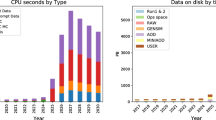Abstract
The particle detectors at the LHC produced about 25 PB data in a year, and the total size of data recorded on tape media at the CERN data center reached almost 100 PB in 2013. In order to preserve such a large-scale data safely and process them fast and efficiently, the collaboration of the data centers around the world (WLCG) was founded. The overall performance of the WLCG has strong site-dependency, and the time scale for the result is unpredictable. In this paper, we introduce PROOF developed for providing high performance and reliable environment for the user analysis task to complement the grid computing, and we provide a new Linux cluster (KIAF), by deploying PROOF. The KIAF cluster provides data access in low latency and secure connection with the clients. In order to find the correlation between the processing performance and the scalability of KIAF, we perform a simple analysis task counting the number of particles in the data on KIAF by varying the number of worker nodes from 1 to 96. We show that the linear scalability of performance of KIAF and its limitation as a function of the number of workers participating in processing.





Similar content being viewed by others
Notes
Stands for “Conseil Européen pour la Recherche Nucléaire”s (French).
Korea Institute of Science and Technology Information.
Joint Institute for Nuclear Research.
Stands for “Laboratoire de physique SUBatomique et des TECHnologies associées” (French).
References
Evans L, Bryant P (2008) LHC machine. J Instrum 3:S08001
The ALICE Collaboration (2008) The ALICE experiment at the CERN LHC. J Instrum 3:S08002
The ATLAS Collaboration (2008) The ATLAS experiment at the CERN large hadron collider. J Instrum 3:S08003
The CMS Collaboration (2008) The CMS experiment at the CERN LHC. J Instrum 3:S08004
The LHCb Collaboration (2008) The LHCb detector at the LHC. J Instrum 3:S08005
CERN. Models of networked analysis at regional centres for LHC experiments. http://monarc.web.cern.ch/MONARC/
Bird I (2011) Computing for the large hadron collider. Annu Rev Nucl Part Sci 61:99–118
The ATLAS Collaboration (2012) Observation of a new particle in the search for the Standard Model Higgs boson with the ATLAS detector at the LHC. Phys Lett B 716:1–29
The CMS Collaboration (2012) Observation of a new boson at a mass of 125 GeV with the CMS experiment at the LHC. Phys Lett B 716:30–61
Ballintijn M et al (2006) Parallel interactive data analysis with PROOF. In: Proceeding(s) of ACAT05 workshop, nuclear instruments and methods in physics research section A. vol 559, pp 13–16
Brun R, Rademakers F (1997) ROOT—an object oriented data analysis framework. In: Proceedings AIHENP’96 workshop, nuclear instruments and methods in physics research section A, vol 389, pp 81–86 (1997). See also http://root.cern.ch/
The ALICE Collaboration (2012) Letter of intent for the upgrade of the ALICE experiment. CERN-LHCC-2012-012, LHCC-I-022
Antcheva I et al (2009) ROOT—A C++ framework for petabyte data storage, statistical analysis and visualization. Comput Phys Commun 180:2499–2512
Ganis G, Iwaszkiewicz J, Rademakers F (2007) Scheduling and Load Balancing in the Parallel ROOT Facility (PROOF). In: Proceedings of science (ACAT) 022
Buncic P et al (2010) CernVM a virtual software appliance for LHC applications. J Phys Conf Ser 219:042003
Hanushevsky A, Wang DL, Scalla: Structured cluster architecture for low latency access. 2012 IEEE 26th, international parallel and distributed processing symposium workshops and Ph.D. Forum (IPDPSW), pp 1168–1175 (2012)
California Institute of Technology. Monitoring agents using a large integrated services architecture. http://monalisa.caltech.edu/monalisa.htm
Acknowledgments
This work was supported by the National Research Foundation of Korea (NRF) through contract N-13-NM-IR04.
Author information
Authors and Affiliations
Corresponding author
Rights and permissions
About this article
Cite this article
Ahn, S.U., Yeo, I.Y. & Park, S.O. Secure and efficient high-performance PROOF-based cluster system for high-energy physics. J Supercomput 70, 166–176 (2014). https://doi.org/10.1007/s11227-014-1146-5
Published:
Issue Date:
DOI: https://doi.org/10.1007/s11227-014-1146-5




